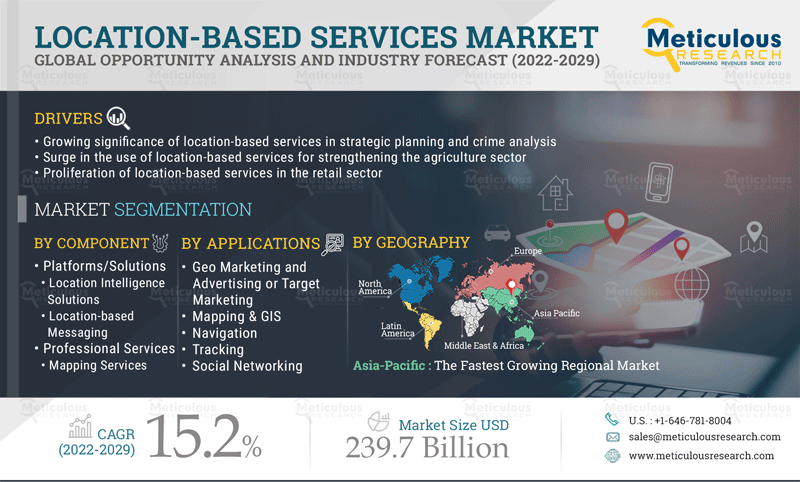
The global market for Location-based Services is anticipated to grow to $327.6 billion by 2031, reflecting a compound annual growth rate (CAGR) of 15.9% between 2024 and 2031.
Spatial data analysis refers to the examination and interpretation of data that is tied to specific geographic locations or regions. It entails using specialized tools and techniques to analyze and visualize data that has a spatial or geographic component. This type of analysis is invaluable in various disciplines like geography, environmental science, urban planning, and epidemiology. By applying spatial data analysis, researchers can uncover patterns, trends, and relationships in the data, many of which are influenced by geographic factors such as location, proximity, and distribution. A Geographic Information System (GIS) is one of the most commonly used tools in spatial data analysis, providing users with the capability to map, analyze, and interpret spatial data effectively.
Download Sample report : https://www.meticulousresearch.com/download-sample-report/cp_id=5252
Spatial data analysis has applications in a wide range of industries, where it provides valuable insights for informed decision-making based on geographic and location-specific data. Several major industries are particularly reliant on spatial data and analytics:
Retail & Marketing: In the retail sector, spatial data analysis is used to identify ideal store locations, understand the demographics of potential customers, and streamline supply chain logistics. This data helps retailers to optimize operations and improve customer experiences by tailoring products and services to regional preferences.
Agriculture: In precision agriculture, spatial data analysis allows farmers to optimize planting, irrigation, and fertilizer usage based on variations in soil conditions, weather patterns, and other environmental factors. This enables more efficient resource use and improved crop yields.
Healthcare: Healthcare providers use spatial data to analyze the spread of diseases, assess the accessibility of medical services, and plan the location of new healthcare facilities. It helps public health officials understand and address health disparities influenced by geographic factors.
Transportation & Logistics: Transportation companies utilize spatial data analytics to optimize routes, monitor vehicle locations, and identify congestion hotspots. It enables them to improve efficiency, reduce costs, and enhance the customer experience through better route planning and fleet management.
Telecommunications: Telecom companies rely on spatial data to plan network coverage and optimize the placement of cell towers. By doing so, they can ensure better service quality for customers in both urban and rural areas.
Energy: The energy sector uses spatial data analysis for the strategic planning and optimization of renewable energy projects such as wind farms and solar installations, as well as the placement of traditional power plants.
Browse in Depth : https://www.meticulousresearch.com/product/location-based-services-market-5252
As the use of spatial data and analytics continues to expand, industries are discovering innovative ways to harness the power of geospatial intelligence. Many organizations are adopting advanced location-based solutions to enhance their operations. For example, in December 2023, Ocient Inc., a leading hyperscale data analytics platform in the U.S., introduced OcientGeo. This suite of spatial database features is designed to improve spatiotemporal query performance and analytics at scale. OcientGeo boasts the industry’s largest library of geospatial functions and is optimized for analyzing objects on land, air, and water. It has applications in various sectors, including government, automotive, and telecommunications. Developments like this, combined with the growing use of spatial data and analytics across multiple industries, are driving significant growth in the location-based services market.
Quick Buy : https://www.meticulousresearch.com/Checkout/85961718
Location-based Services Market Report Summary:
| Particular | Details |
| Number of Pages | 394 |
| Format | |
| Forecast Period | 2024-2031 |
| Base Year | 2023 |
| CAGR | 15.9% |
| Estimated Market Size (Value) | $327.6 billion by 2031 |
| Segments Covered | By Component
By Technology
By Application
By Location Type
By End-use Industry
|
| Countries/Region Covered | Asia-Pacific (China, Japan, India, Singapore, South Korea, Australia & New Zealand, Taiwan, and Rest of Asia-Pacific), North America (U.S. and Canada), Europe (U.K., Germany, France, Spain, Italy, Netherlands, Switzerland, and Rast of Europe), Middle East & Africa, and Latin America. |
| Key Companies | HERE Global B.V. (Netherlands), Google LLC (U.S.) (a subsidiary of Alphabet Inc.), TomTom N.V. (Netherlands), Esri (U.S.), Hexagon AB (Sweden), Trimble Inc. (U.S.), Cisco Systems, Inc. (U.S.), QUALCOMM Incorporated (U.S.), Microsoft Corporation (U.S.), AT&T Inc. (U.S.), Zebra Technologies Corporation (U.S.), International Business Machines Corporation (U.S.), ALE International (France), Precisely (U.S.), Rohde & Schwarz GmbH & Co. KG (Germany), and Nextbillion.AI Pte. Ltd. (Singapore) |
About Meticulous Research®
Meticulous Research® is a leading provider of comprehensive market intelligence, offering actionable insights and analysis across various industries. Our reports empower businesses to make informed decisions, drive growth, and remain competitive in a rapidly evolving marketplace.
Contact:
Meticulous Market Research Pvt. Ltd.
1267 Willis St, Ste 200 Redding,
California, 96001, U.S.
USA: +1-646-781-8004
Europe : +44-203-868-8738
APAC: +91 744-7780008
Email- sales@meticulousresearch.com
Visit Our Website: https://www.meticulousresearch.com/
Connect with us on LinkedIn- https://www.linkedin.com/company/meticulous-research







